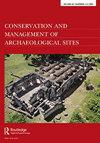火侵蚀岩石艺术所需的风化阈值:美国亚利桑那州中部霍霍坎岩画的案例研究
IF 0.8
4区 历史学
0 ARCHAEOLOGY
Conservation and Management of Archaeological Sites
Pub Date : 2022-11-14
DOI:10.1080/13505033.2022.2133790
引用次数: 0
摘要
本文章由计算机程序翻译,如有差异,请以英文原文为准。
Threshold of Weathering Needed for Fire to Erode Rock Art: Case Study of a Hohokam Petroglyph, Central Arizona, USA
ABSTRACT A Sonoran Desert petroglyph panel experienced an intense wildfire event in July 2021 that eroded the entire surface, removing the Hohokam-style rock art. Field observations during sampling in 1995 indicated that the panel: (1) was coated with a heavy rock varnish, (2) had a ‘fresh’ visual appearance, and (3) had some granite-derived sand (angular grus) at the panel’s base. Micron-scale back-scatter and nanoscale transmission electron microscopy of pre-fire samples revealed a minimal amount of decay (granite grussification): mainly minor grain-to-grain separation; minor internal dissolution; and a little feldspar grain cracking. Our basic finding is that even this minimal amount of grussification was enough to set the stage for the wildfire to erode the entire panel. Pre-fire micron-scale cracking may have enabled the fire’s steep thermal gradient to spall the surface. Panel erosion was likely enhanced by pre-existing grain-to-grain porosity to facilitate further fire-induced granular disintegration. Pre-fire nanoscale dissolution within mineral grains, formed along crystal defects, provided a weakness that then led to grain cracking of quartz and other granitic minerals. The implication for the conservation of rock art on granitic panels is worrisome, but clear and simple: condition assessments need to indicate whether any granitic sand occurs at a panel’s base. Given that many places experiencing climate change are also experiencing drought and enhanced risk from wildfire, the appropriate management recommendation would then be to remove all vegetation near the panel on a regular basis.
求助全文
通过发布文献求助,成功后即可免费获取论文全文。
去求助
来源期刊

Conservation and Management of Archaeological Sites
ARCHAEOLOGY-
CiteScore
0.40
自引率
0.00%
发文量
1
期刊介绍:
The journal Conservation and Management of Archaeological Sites (CMAS) has established itself as the primary reference in this field, both for active professionals and for university teachers and students. Launched in 1995, it is the only journal that covers both theoretical and practical issues in heritage site management and conservation. Peer-reviewed papers from around the world report on new thinking and best practice in site management and conservation. Topics covered include: •Cultural, social, ethical and theoretical issues in archaeological site management and conservation •Site management •Historical documentation and condition reporting •Site deterioration and environmental monitoring •Preventative conservation, including reburial and protective sheltering of sites •Building materials analysis and treatment •Restoration and reconstruction of buildings •Visitor management and sustainable tourism •Site interpretation •National and international legislation and charters
 求助内容:
求助内容: 应助结果提醒方式:
应助结果提醒方式:


